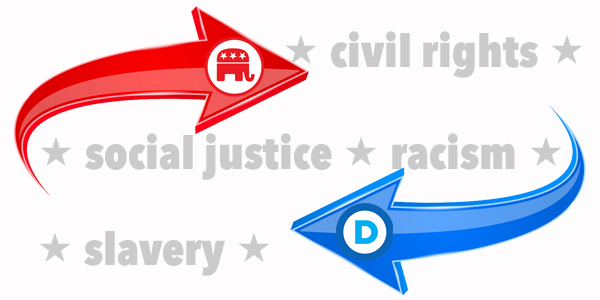
The Switch
Written by Chistine Misner
Switching Party Histories and Whatever Else it Takes to Make History Convenient
Have you heard the news? America’s two main political parties have switched. The Party of Lincoln is now the party of slavery and oppression, while the Party of FDR is the party of free speech and people’s rights. Are you surprised? Having earned degrees in and relating to history and political science, it surprised me.
I first learned about the “switch” theory while reading the usual culprits —) Facebook and Twitter. The theory is usually brought up in discussions concerning BLM, racial division, and racism. The article most often pointed to by the Left as proof was published by Live Science in September 2012, in which Writer Natalie Wolchover repeats Professor Eric Rauchway’s 2010 claims that the switch began at the start of the 20th century with Populist and Democrat William Jennings Bryan’s emphasis on “the government’s role in ensuring social justice through expansion of federal power — traditionally, a Republican stance.” Incidentally, Jennings Bryan was a native of Illinois, born in Salem on March 19, 1860. He would later become a Nebraskan senator and run twice, unsuccessfully, for president.
According to the article, the switch wasn’t complete until 1936 when Democrat Franklin D. Roosevelt won re-election “on the strength of the New Deal, a set of Depression-remedying reforms including regulation of financial institutions, founding of welfare and pension programs, infrastructure development and more.”
The article fails to take into account Jim Crow laws, which originated in the Democrat-dominated South, and the Democrat-led filibuster of the 1964 Civil Rights Act. Not to worry, however — others have taken up that cause. They explain it by blaming the Dixiecrats, Democrats from the South who still favored states’ rights. They also claim that the same Dixiecrats would later leave the Democrat Party to join the Republicans as part of that party’s Southern Strategy.
The filibuster, led by Democrat U.S. Senators Richard Russell, Strom Thurmond, Robert Byrd, William Fulbright, and Sam Ervin, lasted 60 days. Everett Dirksen, Republican U.S. Senator from Illinois, played a key role in negotiations to end what still holds the record as the longest filibuster in U.S. history.
Republican and Illinois State Senate candidate, Dr. Eric Wallace, wrote about the topic on his blog and calls it an “urban legend.” Wallace says,
Contrary to legend, it makes no sense for them [Dixiecrats] to join with the Republican Party whose history is replete with civil rights achievements. The answer is, they returned to the Democrat party and rejoined others such as George Wallace, Orval Faubus, Lester Maddox, and Ross Barnett. Interestingly, of the 26 known Dixiecrats (5 governors and 21 senators) only three ever became Republicans: Strom Thurmond, Jesse Helms, and Mills E. Godwind, Jr.
He noted that “a person advocating for state’s rights should be able to do so without being labeled a segregationist. For conservatives, ‘the rights of the people’ include all races, creeds, ethnicities, and colors—all U.S. citizens.”
In the wider scope, looking at events of the past year, the theory appears to be part of a larger and continuing push to revise or erase other inconvenient parts of history in an effort to change and then maintain the current narrative. In essence, if the definition of a word or phrase doesn’t fit the narrative, change it. If the unfolding of history doesn’t suit current standards of beliefs, change it. In this way, we’ve come to meet George Orwell’s dystopian vision in 2020, more than 70 years after the publication of 1984.
The term “revisionist history” came into the public domain in the 1980s. While the term isn’t used as often now, it’s still occurring and moving at a rapid pace as the switch exemplifies. Another example is The 1619 Project, which sought to revise the history of our nation’s birth from 1776 back to the year 1619 when the first African slaves were brought to Virginia. It also alleges that the central reason for the country’s founding was to perpetuate the practice of slavery. Proponents of the project say it’s only correcting long-ignored history. The movements to decolonize the teaching of history, along with the renaming of towns and buildings, can be interpreted in much the same way.
While it’s important that our history tells the stories of Americans in all segments of our society, it should be done not as a retelling, but as an addition to the historical account. Those who would pander to emotions or stir up old grievances are self-serving and seek to drive wedges rather than unify our nation as a people.
This revisionist history mirrors a larger cultural movement in the West where traditions, standards, morals, and ideas in general that were once considered “the norm” are in many cases now being turned 180 degrees.
We can debate if the taking down of statues followed the pattern of the French or Bolshevik Revolutions (the Bolsheviks did look back to the French for an example), or whether some protests over the summer featured Maoist struggle sessions. But it’s through this revisionist history and the move toward socialism (or even Marxism) that we’re seeing a cultural revolution take place. The final outcome of this revolution depends on multiple factors, including an unseen spiritual battle, but we must prevail, or this nation that was born in 1776 will cease to exist. At the very least, it will cease to exist in a form that would be unrecognizable to our Founding Fathers, and at the worst, it will dissolve into a Civil War with foreign invaders picking over the pieces.
HELP: Our get-out-the-vote campaign is up and running. We are distributing the IFI Voter Guide to hundreds of churches, civic groups and tea party organizations. Will you financially support our endeavor to educate Illinois voters and promote Christian family values?














